Alan Wake 2: how does PS5 Pro handle one of the best-looking games of this generation?
Impressive ray tracing, but question marks over performance and PSSR image quality.
Alan Wake 2 made it onto our best graphics of the year list in 2023, so how does the game hold up now that it sees a full PS5 Pro release?
After all, the PS5 version was already an impressive technological showcase, but it did have its limitations - including image quality issues inherent to low-res FSR 2 upscaling and few of the ray-traced elements of the PC version. Does the PS5 Pro solve those issues by adding in RT and PSSR upscaling? And can it come close to the PC release, with its advanced RT feature set and DLSS upscaling?
Let's start with the quality mode, which we tended to recommend on the base PS5 thanks to its better image quality and more advanced visuals, despite performance sometimes falling below the 30fps cap. The PS5 Pro version adds in the RT reflections missing on the amateur PS5, which are most evident on surfaces like water or glass and look significantly more realistic than the hybrid SSR and SDF solution on the base console, with fewer visual errors and less noise.
Shadow filtering also seems to have been improved slightly, and other settings don't appear to have changed from PS5 to PS5 Pro. That means there's no RT shadows or RTAO as in the PC version, but RT reflections are probably the best bang-for-the-buck upgrade so their selection for the PS5 Pro version makes sense.
Alan Wake 2 also uses the PSSR upscaler on PS5 Pro, which we'd expect to improve image quality. The original PS5 release uses FSR 2 with a base res of 1270p, while the PS5 Pro release is actually slightly lower at 1224p internally. We generally consider PSSR to be a better upscaler than FSR 2, but the result here is mixed at best. There's more image instability with PS5 Pro in still shots and it almost looks like a film grain is overlaying the image, though film grain and other post-processing effects were disabled in the menu before testing.
In motion, PSR does look better overall, with fewer disocclusion artefacts and better handling of fine detail, such as Saga's hair. However, it also struggles with some elements that FSR 2 handles well, such as the rendering of thin power lines while walking forward. We don't normally recommend this, but it's worth disabling motion blur in the quality mode on PS5 Pro, as this seems to result in extra aliasing during camera movement.
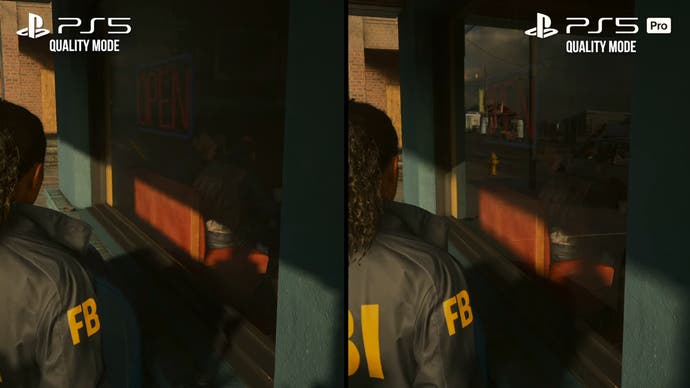
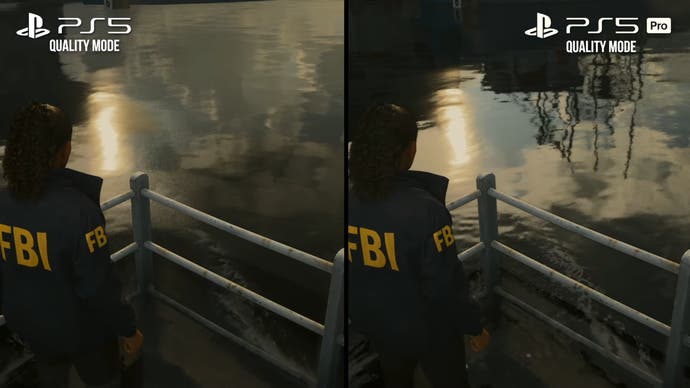
So a bit of a mixed bag there - better-quality visuals, but a few image quality and anti-aliasing. The good news is that quality mode does improve performance in the most demanding areas of the game, the foliage-heavy forest scenes that dropped into the mid-20s on PS5. These aren't perfect on PS5 Pro, but the single frame drops in these areas are much less intrusive overall.
Moving onto the 60fps performance mode, this mode had a noticeably soft resolve on the base PS5 with an internal resolution of 847p at its lowest. This isn't majorly improved on PS5 Pro through the use of PSSR upscaling, with a similar 864p internal resolution and similar blurry results. As before, image instability is an issue while stationary, though disocclusion artefacts are less obvious in motion. The good news is that settings have been bumped up to around the level of the old quality mode, including foliage density, volumetric lighting resolution and shadow rendering at distance.
In terms of frame-rates, the original performance mode ran at 55-60fps in forested areas and was generally 60fps elsewhere. The game actually runs worse on PS5 Pro, generally being ~3fps slower in forested scenes, though it remains above the 48fps threshold that determines whether VRR displays are able to gracefully handle the drop below 60fps.
That's a bit of a disappointment given the Pro's improved RT acceleration, fancier upscaling and bigger graphics processor overall, and perhaps suggests that keeping settings the same while boosting internal resolution further might have had better results.
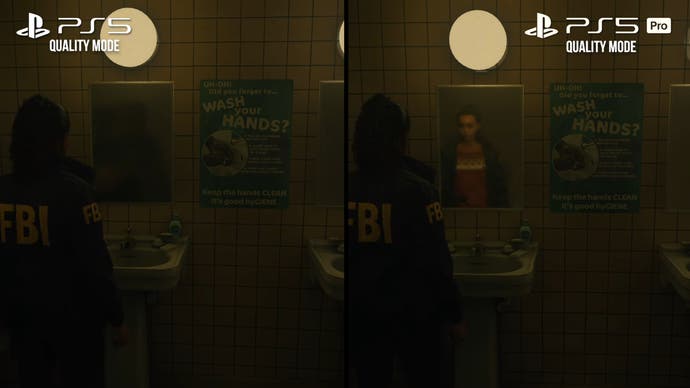
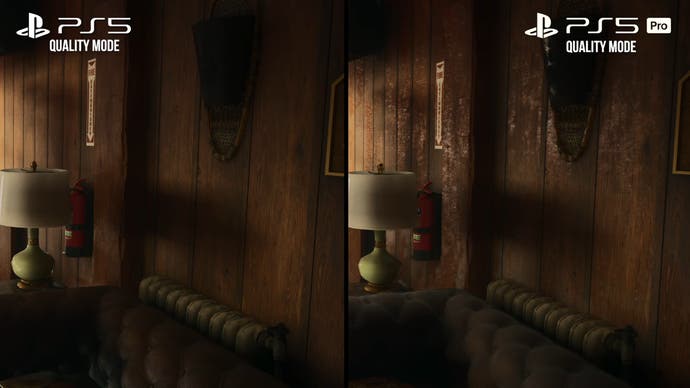
As well as being a great game in its own right, Alan Wake 2 also provides a good opportunity to compare PSSR with DLSS at similar settings and internal resolutions, something we've only been able to do with Insomniac titles like Ratchet and Clank: Rift Apart before now. Alan Wake 2 is particularly interesting as it's using the maximum 2.5x scale afforded by PSSR (864p to 2160p) and doesn't use dynamic resolution scaling in its console iteration, unlike Ratchet and Clank.
We set up an RTX 4070 PC with a custom 864p resolution and the ultra performance scaling mode preset using the Nvidia Profile Inspector utility. Here, both upscalers struggled with the low internal resolution, but DLSS was more temporally stable and better rendered subpixel detail, such as the links in a distant chain link fence. This is more obvious when the camera is still, with more jitter or film grain like artefacts on the PSSR image, but in motion DLSS also does better in terms of aliasing and flicker. Some on-screen effects like SSAO, volumetrics or SSR, also appear more unstable in PSSR than in DLSS or even FSR 2.
Still, PSSR is still early in its development, and there's room for it to improve beyond FSR 2 and start to approach DLSS in quality. We've already seen it perform better in Insomniac's output, so it may be that it just doesn't mesh as nicely with Alan Wake 2's more realistic style as of yet.
Alan Wake 2 also offers an interesting comparison between PS5 Pro and PC when it comes to RT, with Remedy seemingly choosing unique settings for their RT implementation on Pro that can't be matched exactly with the PC presets.
For example, reflections in puddles are visible when first taking control of Saga in the PC version, even on its lowest RT setting, while these are missing on PS5 Pro as the BVH has been made smaller. However, while the BVH lacks some elements, eg distant trees, the height map - the terrain of the area - is always included and therefore shows up in reflections even far away. The update rate for the BVH is also halved, which helps keep performance higher in the heavy forest scenes.
Denoising is also optimised for the PS5 Pro release, so mirror-like surfaces look a little less mirror-like, and the cutoff for hardware RT is also different. That means surfaces that are slightly less shiny may use RT on PC, but use a fallback software method on PS5 Pro. Interestingly, the denoiser here seems a bit more reactive with less temporal weighting, so while it fails heavily in the wooden surfaces in the lodge on PS5 Pro, but better handles the reflections of the moving mascots versus PC running without ray reconstruction.
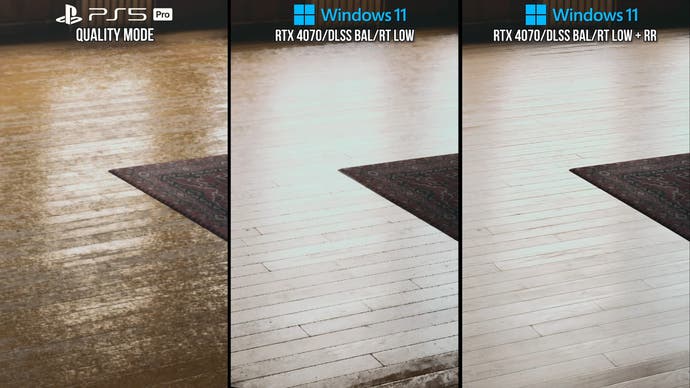
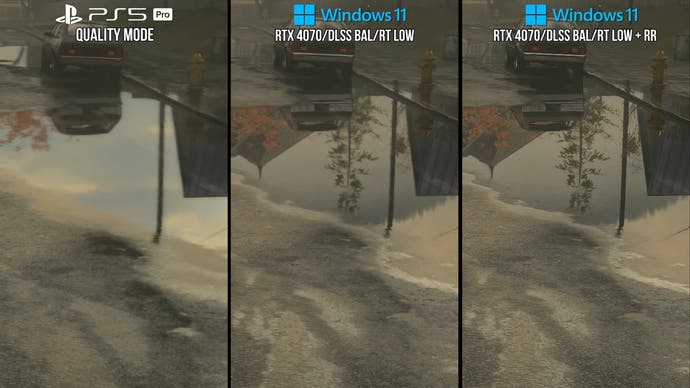
Finally, running the forest scene on PS5 Pro and on a PC with as closely matched settings as possible gives us an idea of the Sony console's performance level versus PC graphics cards. The RTX 4070 is a natural point of comparison, but the game actually runs around 45 percent faster on PC in a matched scene. The RTX 3070 is closer, running around 10 percent faster than PS5 Pro, while the RTX 2080 Ti is two percent slower on average.
This is of course only one scene in one game, but it does suggest that the PS5 Pro's graphics performance level is a little bit less than what we might have expected given its specifications. Still, it's an interesting early data point, and it'll be fascinating to see whether it's emblematic of future PS5 Pro releases or whether it's a particularly difficult fit for PSSR and the PS5 Pro hardware.
Alan Wake 2 on PS5 Pro is one of the most interesting releases for the system thus far, as it delivers exactly what we expected from the premium Sony machine in some areas, like the inclusion of RT features, but falls behind in others, like image quality. It's still early days for both PS5 Pro and this particular release, and I hope that we'll see both continue to improve over time.



.jpg?width=291&height=164&fit=crop&quality=80&format=jpg&auto=webp)






